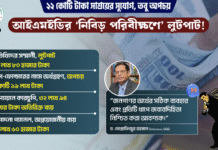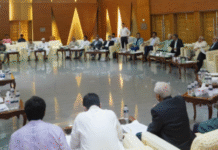City streets shout out, loud and clear
 The sights and sounds of the city speak louder than any words. The teeming masses, the blaring horns, the graffiti, the air in which laughter, cries and shouts, mingle with the smog and smells of the cosmopolis – life never pauses in Dhaka city.
The sights and sounds of the city speak louder than any words. The teeming masses, the blaring horns, the graffiti, the air in which laughter, cries and shouts, mingle with the smog and smells of the cosmopolis – life never pauses in Dhaka city.
What city could be more expressive and voluble than Dhaka? It’s a city that hardly sleeps. Bustling and busy during the day, even the nights are filled with the rumble of trucks laden with an assortment of cargo, from cattle to cabbages and eggs to eggplants. Construction work carries on, breaking the silence of the night. Lights and noises are emitted from the hi-rise apartment buildings where the sleepless inmates surf the channels or Facebook throughout the night till the early hours of morn. (Beware, it is reported that the Japanese are having less and less sex because they are so engrossed with their hi-tech gadgets, that they are opting for the virtual over the real thing!)
What does Dhaka say?
At the traffic intersection where the moving convoy of bumper-to-bumper traffic comes to a halt as the traffic lights turn red, the city has so much to say. The little flower girl, her face smudged with dirt and poverty, pleads with the passengers ensconced in the air-conditioned interiors of their luxury cars, to buy a garland or two. This sight speaks more than words. The little girl is on the streets under the mid-morning sun (or in the pouring rain), when ideally she should be in school, counting numbers in the copy books, not counting the soiled taka notes in her hands. It’s about education, child labour, child rights, social inequity, human dignity. So much leaps out from this scene, so much injustice, sorrow, and guilt. But that cheeky smile on the girl’s face speaks volumes. It speaks of a resistance born from generations of struggle, of fighting against all odds.
And the BMW, its engine purring patiently and horn honking impatiently as the red light turns amber, also has a tale to tell. It speaks of the expanding wealth quotient, of the rich growing richer, of the economic boom which is pushing Bangladesh out from the LDC bracket to the echelons of mid-income nations. The BMW and the beggars are clichéd juxtaposition of rich and poor. Cliché or not, the glaring inequity jars one conscience.
Then there are the street vendors that reflect the informal economy of the city. “Towels, towels, towels!” shouts the vendor, offering a tempting bargain, waving his colourful ware in the face of the potential customers, “Four for only 100 taka! Soft towels going cheap!” The haggling begins and the traffic lights turn green. The potential customer speeds away, leaving the towel walla muttering choice expletives. Or, if he is lucky, the customer takes the towels and leaves with a good payment, no time to take the change.
Further down the city roads, the disruption is actually a guise of development. The wide ‘VIP’ road has been reduced to less than half in width, a long scar running down its length, like a surgery in process. This is the Metro Rail project underway. This project promises to cure the metropolis of its congested commute syndrome. So even while glaring at the ugly gash that runs through the city, the commuter looks at it with hope. Surely the Metro Rail will take a load off the roads and cut travel time by more than half. So the message here, despite the travails of travel, is one of hope, development and a better future. And the corruption involved? Collateral damage.
Then there’s the street food. Yum! The roadside chotpoti – spicy and tasty to the extreme. Who can resist? Even the fear of germs can’t deter the food lover from ordering a plate or two… or three. Street food speaks of change, of changing trends and tastes. The roadside food carts sell momos nowadays, the steamed dumplings gaining currency as a common roadside snack, alongside the phuchka-chotpoti combo.
Sugar cane juice has been, and still is, an all-time favourite, pedestrians pouring the sweet icy drink down their parched throats on a hot summer’s day. But the bazaars are abuzz with a trendier and healthier juice too nowadays – aloe vera. Hitherto restricted to health fanatics of the western world, aloe vera juice has become a popular drink on the roadside here. The long fleshy leaves are stacked up on the makeshift stalls as the vendors scrape out the sticky gel to make a refreshing and healthy drink for anyone who cares to taste.
Still on the subject of food, long slices of pineapple liberally seasoned with salt, chilli powder and kasundi (a mustard concoction), sell like hot cakes on the street side. (Hot cakes sell like hot cakes too, but that’s a winter’s tale.) But the vendors also roam the streets with a ‘western’ fruit, strawberries. They may not be as succulent or sweet as in the lands of the origin, but the increasing number of locally grown strawberries indicates a diversification in agriculture. While the holy trinity of ‘aam, jaam, lichu’ remain firmly established at the pinnacle of popularity, bizarre (to us) fruits appear besides these mangoes, jaams and lychees at the fruit stalls – dragon fruit, kiwi fruit, rambutan and more. We are apparently emerging from out comfort zones of fruit and venturing out to newer tastes.
What about the people on the streets? Ah, what stories they have to tell. There are the ‘mastaans’, the hoodlums hired by the ‘dons’ to collect ‘toll’ from the local businesses, beggars included. Are they politically linked? Yes, to whichever party is at the helm at the moment.
There are the traffic police. We may castigate them for taking bribes and not managing the traffic efficiently, but they deserve a huge thanks and even huger empathy from the denizens of Dhaka. We get fed up spending an hour or two in traffic, yet these unsung heroes spend the entire day under the relentless rays of the scorching sun, breathing in the world’s worst pollution, amidst blaring noise enough to render anyone deaf and inhaling the stench of garbage, trying to untangle the traffic that defies all rules, regulations and logic. They try to bring order to the disorder, facing the challenge of a daunting chaos on the streets of Dhaka. Hats off to these policemen and women.
The walls speak loud and clear too, pasted with posters that tell us where to learn spoken English, where to go for coaching classes for admission into cadet colleges or BUET or medical colleges. Where to go to get your visa forms filled up to travel to India, UK, US, Canada or Australia. Squares of tin are hammered to the trees, offering us cures for any sort of disease, from piles to impotence. So we get a picture of the state of our education, migration, healthcare, and the picture is far from perfect. It also points to our lack of civic sense and environmental awareness. How can one mar a freshly whitewashed wall with luridly coloured posters or how can one cruelly hammer nails into a tree, its sap oozing out and pouring down like tears of pain?
The city streets tell us so much more. It tells us about the sex worker who roams the alleys at night, her hungry stomach forcing her to cater to the carnal needs of the customer. The limbless beggar who is placed at strategic corners every morning by the syndicate who takes a percentage of his alms. The pickpocket who is beaten to near death for helping himself to 50 taka, while the leaders of the land siphon off 5000 crores without a qualm.
Then when a young man helps an old beggar woman across the street, when a poor rickshaw puller returns a fat wallet accidently left behind by a passenger, when a schoolgirl gives away her tasty tiffin to a homeless kid near her house, and when a traffic sergeant stops a minister’s car from driving down the wrong side or the road, fully aware of the consequences, then the streets give us a message – don’t give up. Don’t lose hope.









